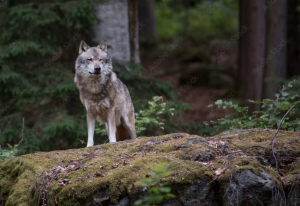Reintroducing Wolves Under the Drive for Net Zero
A recent plan to reintroduce wolves into Scotland’s Highlands has stirred heated controversy. Advocates claim that reintroducing these apex predators might help limit red deer populations, boost native woodland regeneration, and contribute to the UK’s net-zero carbon emissions objective. Critics, however, express alarm about the potential effects on cattle and local residents.
 Red deer numbers in Scotland have increased in the absence of natural predators such as wolves, resulting in overgrazing and impeding forest growth. This overpopulation causes environmental damage and increased carbon emissions. A study shows that importing roughly 170 wolves might lower deer numbers, allowing woodlands to recover and store up to one million tonnes of CO₂ yearly, considerably contributing to the UK’s climate goals.
Red deer numbers in Scotland have increased in the absence of natural predators such as wolves, resulting in overgrazing and impeding forest growth. This overpopulation causes environmental damage and increased carbon emissions. A study shows that importing roughly 170 wolves might lower deer numbers, allowing woodlands to recover and store up to one million tonnes of CO₂ yearly, considerably contributing to the UK’s climate goals.
The ecological benefits of wolf reintroduction are clear. In Yellowstone National Park, wolves have restored ecosystem balance by reducing prey populations, resulting in increased biodiversity. Similar results should be expected in Scotland, where healthier woodlands support diverse biodiversity and improve carbon sequestration.
However, the project is opposed, mainly by farming areas concerned about livestock predation. According to studies, while wolves can have an impact on cattle populations, appropriate management solutions, such as compensation systems and protective measures, can reduce these consequences. Public sentiment varies, with urban residents being more supportive than rural regions directly affected by prospective reintroduction.
Economic concerns play an important influence. The current cost of deer culling is significant. Reintroducing wolves could lower these expenses by naturally reducing deer populations. Furthermore, wolf-related tourism has proven profitable in places such as Yellowstone, indicating potential economic benefits for Scotland.
Implementing such a reintroduction takes significant consideration. Engaging stakeholders, such as local communities, conservationists, and lawmakers, is critical. Creating comprehensive management plans that address ecological, economic, and social issues will be critical to the initiative’s success.
While returning wolves to Scotland poses problems, the potential ecological and economic benefits are worth serious study. Balancing environmental restoration and community interests may pave the road for a more sustainable and biodiverse future.
Sources:
- “Reintroduce wolves to Highlands ‘to help reach net zero'” – The Times
- “Wolves’ reintroduction to Highlands could help native woodlands to recover, says study” – The Guardian
- “Reintroducing wolves to Scotland after 400 years ‘would help control deer numbers'” – The Telegraph
- “Reintroducing wolves to Scottish Highlands could help address climate change” – Phys.org
- “Wolf reintroduction to Scotland: Public attitudes and consequences for red deer management” – ResearchGate

Leave A Comment
You must be logged in to post a comment.